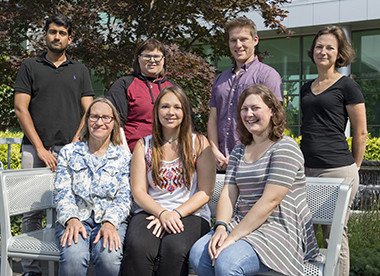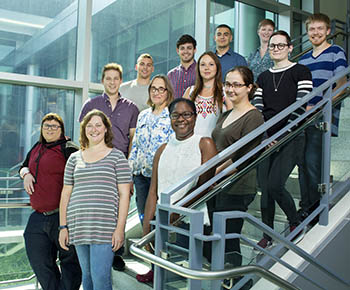Advancing Fellows
 |
|
The newest RNA Fellows with faculty mentors Prashanth Rangan, upper left, and Cara Pager, upper right. First row, left to right, Kathryn Dill, Alyssa Hoy and Amber Altrieth. Top row, Jamie Corro and Shane Breznak. (Photos by Carlo de Jesus) |
ALBANY, N.Y. (August 30, 2017) — Student researchers in RNA science conduct studies whose titles are a bit beyond the understanding of most of us. But their intent is clear and vital: the development of therapeutics, technologies and methods to address the most challenging of human health problems. Thanks to a novel program from The RNA Institute, some extremely talented grad students are on an accelerated path to tackling such challenges.
The RNA Fellows Program, entering its third year this fall, welcomes five new Ph.D. candidates in three fields to receive the kind of comprehensive training across curriculum boundaries that prepares them for the intricate world of RNA science. They are, with their departments and projects:
- Jamie Corro, Biomedical Sciences, alternative ribosomes in Mycobacteria species, specifically Mycobacterium tuberculosis and Mycobacterium smegmatis
- Amber Altrieth, Biological Sciences, endothelial cell signaling in submandibular salivary gland regeneration
- Shane Breznak, Biological Sciences, RNA modifications during germline stem cell differentiation
- Alyssa Hoy, Chemistry, synthesis of RNA phosphoramidites incorporating transcyclooctene
- Kathryn Dill, Chemistry, single-molecule experiments to calibrate nucleic acid base-stacking forces in molecular simulations.
Biologist Marlene Belfort, Distinguished Professor and Fellows program director, said “it’s wonderful to be welcoming our third cohort of RNA Fellows. We’re really beginning to build critical mass, with a total of 18 fellows on board now.”
 |
|
New RNA Fellows are joined by alumni of the three-year-old program. 1st row, Jamie Corro and Amber Altrieth; 2nd, Marissa Lewis, 3rd, Shane Breznak, Kathryn Dill and Rebecca D'Esposito; 4th, Ryan McDowell and Alyssa Hoy; 5th, Patrick Blatt and Alicia McCarthy; 6th, Botro Torro and Justin Waldern; top row, Rachel Netzband. |
The program is a collaboration of the Office of Graduate Education, Biological Sciences, Chemistry, Biomedical Sciences and the Institute. Faculty from these areas have joined to create an interdisciplinary curriculum providing comprehensive access to their work and techniques and to help the Fellows form research collaborations.
“One of our goals is to have interdisciplinary programs among the different STEM departments, but that’s very difficult to achieve,” said Belfort. “So it’s exciting to see the students from the three different departments interacting. That happens in their RNA courses, colloquia and even in research.”
The fellows are each guided by a faculty mentor affiliated with the Institute. Biologists Cara Pager and Prashanth Rangan have both worked with multiple fellows. “The most significant benefit of the program has been the confidence and further academic training that my students have gained,” said Pager. “The validation, training and important resume-enhancing aspects of the program have provided a significant enhancement to their Ph.D. experience and has expanded their professional boundaries.
“I feel privileged to now have two past RNA fellows, Rachel Netzband and Marissa Louis, in my lab.”
The students take an RNA-centric curriculum of courses and colloquia, the latter including a once-per-month RNA Fellows Colloquium, in which each Fellow presents his or her current work to a regional gathering of graduate school scholars, mentors and colleagues.
Corro said she was looking for “an unparalleled learning opportunity and to take advantage of a rigorous curriculum. What drew me was the opportunity to learn and to network with other students outside of the BMS department, including networking with the Hudson Valley RNA club.”
Year 2 fellow Louis, now a fourth year Ph.D., cited the value she received from presenting her research in colloquium to both students and faculty. Aly Hoy is among the new fellows looking forward to a like opportunity. “This will help me a great deal in preparing for future presentations,” she said.
Rachel Netzband, a fourth year Ph.D. student, said the program was an aid to her two years ago in becoming acquainted with this particular scientific field. “The fellowship allows you learn the trials and tribulations of what to expect when working with RNA,” she said.
That type of experience is invaluable for the young researcher, said Rangan, who, like Pager, is well-supported in his RNA research by government and foundations. “For me, mentorship means helping people discover and develop their own skills for dealing with real life situations,” he said. “I enjoy watching my mentees grow and become self-sufficient as they charge ahead and forge their own careers."
![]() For more news, subscribe to UAlbany's RSS headline feeds
For more news, subscribe to UAlbany's RSS headline feeds
A comprehensive public research university, the University at Albany-SUNY offers more than 120 undergraduate majors and minors and 125 master's, doctoral and graduate certificate programs. UAlbany is a leader among all New York State colleges and universities in such diverse fields as atmospheric and environmental sciences, business, education, public health,health sciences, criminal justice, emergency preparedness, engineering and applied sciences, informatics, public administration, social welfare and sociology, taught by an extensive roster of faculty experts. It also offers expanded academic and research opportunities for students through an affiliation with Albany Law School. With a curriculum enhanced by 600 study-abroad opportunities, UAlbany launches great careers.


